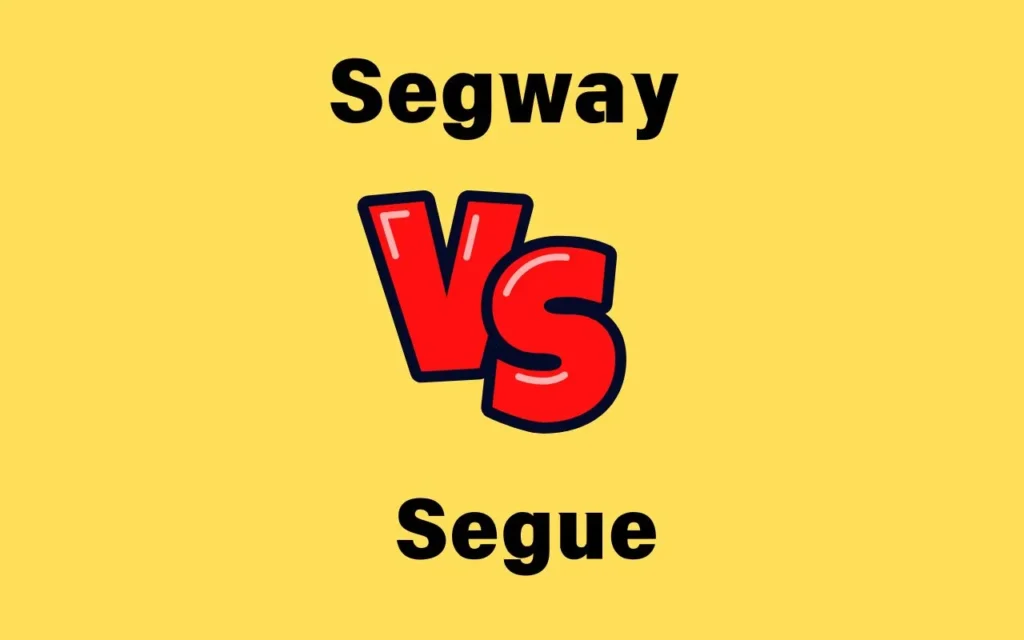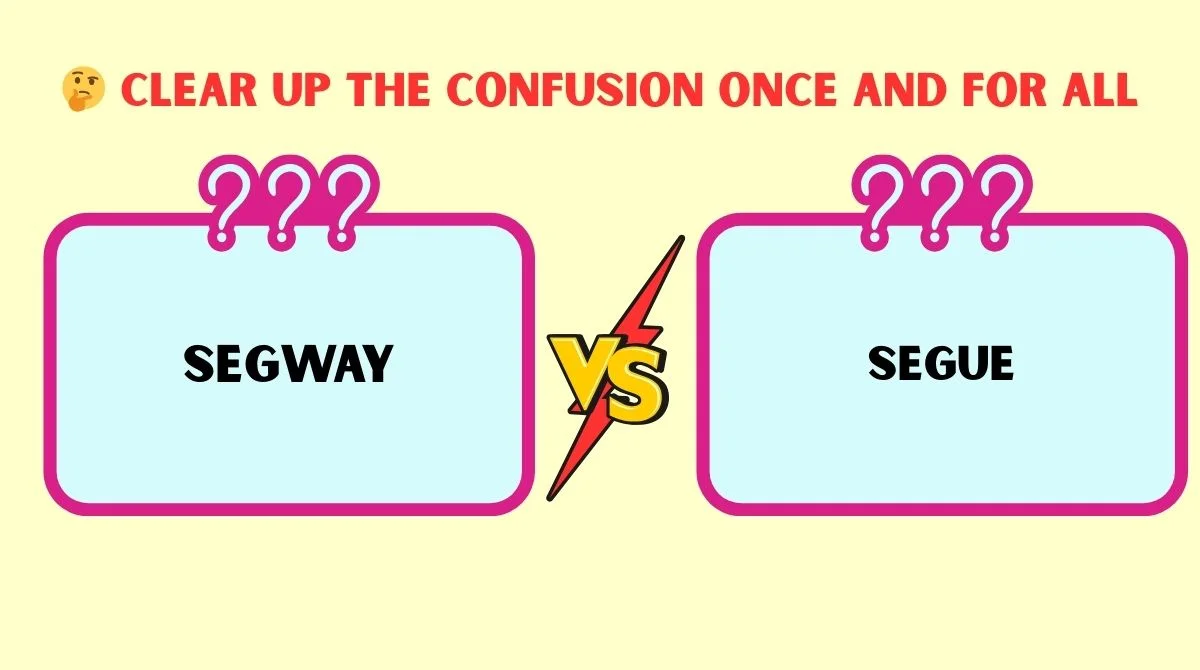Last updated on September 26th, 2025 at 03:28 pm
Confusing Segway and segue is more common than you might think. One is a futuristic, self-balancing scooter, and the other is a smooth transition in conversation or writing.
Despite sounding similar, they belong in entirely different contexts.
This article breaks down their meanings, origins, correct usage, and practical examples, so you’ll never mix them up again.
What Does “Segue” Mean?

The word segue comes from the Italian verb seguire, meaning “to follow.” In English, it has evolved to describe a smooth transition from one topic or section to another in speech, music, or writing.
Think of it like a bridge connecting two ideas. If you’re presenting in a meeting, a good segue helps your audience follow your flow without noticing a jarring shift.
Examples of Segue in Use
- “She finished discussing marketing trends and smoothly segued into customer feedback strategies.”
- In music, one song might segue into another without a pause.
- Television hosts often segue between segments to maintain pacing and audience engagement.
Common Mistakes With Segue
- Writing “Segway” when you mean a conversational transition.
- Overusing the word in writing, making sentences clunky.
- Mispronouncing it as “seg-way” instead of “seg-way” with the emphasis on the first syllable.
What Is a “Segway”?
A Segway is a brand of self-balancing, two-wheeled electric personal transporters. Invented by Dean Kamen in 2001, it promised a futuristic revolution in urban commuting.
Unlike a segue, a Segway is tangible—you can touch it, ride it, and even see it in action in city tours or police patrols.
Key Facts About the Segway
- Maximum speed: ~12.5 mph (20 km/h)
- Battery life: ~24 miles (38 km) per charge
- Weight: 100–120 lbs (45–55 kg) depending on the model
- Original price: ~$5,000 at launch
- Current status: Production of original models ceased in 2020, replaced by newer electric scooters and self-balancing vehicles
Where People See Segways Today
- Tourist attractions and guided city tours
- Security and police patrols
- Tech expos and futuristic demonstrations
The Segway’s name has nothing to do with conversation. Confusing it with segue leads to amusing sentences like: “I Segway into my next topic,” which is clearly wrong.
Key Differences Between Segway and Segue
Here’s a handy comparison table to make things crystal clear:
| Feature | Segue | Segway |
|---|---|---|
| Definition | Smooth transition in speech or writing | Electric personal transporter |
| Origin | Italian seguire (“to follow”) | Brand name (Dean Kamen, 2001) |
| Usage Context | Conversation, writing, music | Transportation, commuting, tours |
| Pronunciation | /ˈsɛɡ.weɪ/ | /ˈsɛɡ.weɪ/ |
| Common Mistakes | Using Segway instead | Using Segue for transitions |
Tips to Remember
- Segue starts with “seg,” think “segue to the next point.”
- Segway is a vehicle—visualize riding it.
- If you’re discussing a transition, always pick segue.
Real-World Confusions
- Social media posts often say: “I Segwayed into the next topic,” mixing the words.
- Even journalists occasionally write “Segway” when they mean a smooth transition, highlighting how tricky homophones can be.
How to Use “Segue” Correctly
A proper segue can elevate your writing, speeches, or presentations. Here’s how to master it:
1. Plan Ahead
- Know the topic sequence.
- Identify where one idea naturally leads to another.
2. Use Transitional Phrases
- Examples:
- “Building on that point…”
- “This naturally leads us to…”
- “Speaking of which…”
3. Keep It Natural
- Don’t force a connection.
- A segue should feel like a gentle bridge, not a leap.
4. Practice in Conversation
- Watch skilled speakers: TED Talks are full of smooth segues.
- Try summarizing one topic and linking it to the next in casual dialogue.
5. Use in Writing
- Essays: “Having explored the causes of climate change, we can segue into potential solutions.”
- Blogs: “After covering the main benefits of meditation, let’s segue into practical daily exercises.”
Common Mistakes and How to Avoid Them
Even experienced writers trip over segues. Avoid these pitfalls:
- Using Segway instead of segue – remember, one is a vehicle, the other a transition.
- Overcomplicating transitions – simple phrases often work best.
- Dropping the segue altogether – abrupt topic jumps confuse readers.
- Ignoring tone and pacing – a forced segue sounds unnatural.
Quick mnemonic: Segue = smooth “flow,” Segway = “wheels.”
Fun Facts & Interesting Tidbits
- Segway origins: Dean Kamen hoped the Segway would revolutionize city transport, but it became more of a novelty.
- Segue in pop culture:
- The Tonight Show and late-night hosts use segues to keep interviews lively.
- Musicians often segue between tracks during live concerts to maintain energy.
- Funny mix-ups: One journalist wrote, “The president Segwayed to foreign policy,” causing online amusement.
FAQs
What is a segue?
A segue is a smooth transition from one topic or idea to another in speech, writing, or music.
What is a Segway?
A Segway is a two-wheeled, self-balancing electric personal transporter, invented in 2001.
Can I use Segway to mean transition?
No. Segway is a vehicle. Use segue for smooth topic transitions.
How do you pronounce segue?
It’s pronounced /ˈsɛɡ.weɪ/, rhyming with “legway.”
Where does segue come from?
It comes from the Italian word seguire, meaning “to follow.”
Are segues important in writing or speeches?
Yes. They keep ideas connected, maintain flow, and prevent awkward topic jumps.
Conclusion
Understanding the difference between Segway and segue is simple once you remember:
- Segway is a vehicle, a two-wheeled personal transporter.
- Segue is a smooth transition in speech or writing.
Next time you write an article, give a presentation, or chat casually, use this distinction confidently. Your audience will appreciate your clarity—and you’ll avoid any awkward vehicle-related mishaps in conversation.
